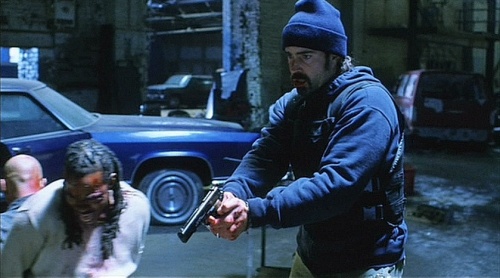Workplace violence happens every hour of every day in America. Whether you are a police officer or a security guard assigned to duties in an office building or department store, it is likely that you will be called upon to respond to such a situation at some point in your career. When that happens, it is crucial that you take the call very seriously. Such situations often erupt when an employee is dismissed or disciplined for an event, or in a manner in which they feel is unjust or unfair. Expect a heated exchange to be taking place between two or more employees when you respond to the scene and be prepared to do what you can to calm the situation and if necessary, separate the individuals who are involved in the confrontation. But each workplace violence event is different so try to adapt your approach in a way that will neutralize the threat and lower the emotion.
Recently, violence in the workplace has received considerable attention in the popular press and among safety and health professionals. Much of the reason for this attention is the reporting of data by the National Institute for Occupational Safety and Health (NIOSH) and others regarding the magnitude of this problem in U.S. workplaces. Unfortunately, sensational acts of coworker violence (which form only a small part of the problem) are often emphasized by the media to the exclusion of the almost daily killings of taxicab drivers, convenience store clerks and other retail workers, security guards, and police officers. These deaths often go virtually unnoticed, yet their numbers are staggering: 1,071 workplace homicides occurred in 1994. These homicides included 179 supervisors or proprietors in retail sales, 105 cashiers, 86 taxicab drivers, 49 managers in restaurants or hotels, 70 police officers or detectives, and 76 security guards [BLS 1995]. An additional 1 million workers were assaulted each year. These figures indicate that an average of 20 workers are murdered and 18,000 are assaulted each week while at work or on duty. Death or injury should not be an inevitable result of one’s chosen occupation, nor should these staggering figures be accepted as a cost of doing business in our society.
The following suggestions may be of assistance in dealing with the situation:
- Get as much information as possible prior to responding to the scene and ask the manager/complainant exactly what it is they want you to do;
- Do not respond alone. Take a manager or another security officer (preferably a supervisor) with you or call for back up as you respond;
- Expect a very volatile situation. Shouting and anger are common. If the situation is calm initially, be prepared for it to escalate when you appear on the scene;
- Greet everyone politely but project an image of authority that will show that you are prepared to use whatever force necessary to prevent any exercise of violence;
- Follow the lead of the manager if he/she is the person who requested your presence;
- If you are asked to escort the individual from the premises, do so politely but firmly, taking the most direct route out of the building and off the property without allowing the individual to make any stops along the way or return to the scene;
- Once outside the building, remain in view, watching the individual until they have walked or driven away from the building. Continue to be watchful for the remainder of the shift and for the next few days in case the individual decides to return;
- If an actual assault has occurred or is anticipated, call the police immediately;
- If an assault has occurred, it may be necessary to take the individual into custody and detain them for the police;
- Always act within the law regarding citizen’s arrest and detention and use the minimum amount of force necessary to control or detain the individual; and,
- Remember; all your actions must be reasonable and necessary.
The Facts
Workplace murder is the leading killer of working females, (35% of their fatal work injuries) and the second leading killer of males. The problem is especially acute in service sector industries such as retail establishments, taxi and limousine, police and security services. According to the figures released on August 3, 1995, by the U. S. Bureau of Labor Statistics (BLS) (1), 1,071 workers were murdered in the workplace in 1994, a slight decrease from 1,074 the previous year. According to the National Institute for Occupational Safety and Health (NIOSH) (2), the following factors may increase workers’ risk of homicide.
Risk Factors
A number of factors may increase a worker’s risk for workplace assault, and they have been described in previous research [Collins and Cox 1987; Davis 1987; Davis et al. 1987; Kraus 1987; Lynch 1987; NIOSH 1993; Castillo and Jenkins 1994]. These factors include the following:
- Contact with the public;
• Exchange of money;
• Delivery of passengers, goods, or services;
• Having a mobile workplace such as a taxicab or police cruiser;
• Working with unstable or volatile persons in health care, social service, or
criminal justice settings;
• Working alone or in small numbers;
• Working late at night or during early morning hours;
• Working in high-crime areas;
• Guarding valuable property or possessions; and,
• Working in community-based settings
Three Prevention Strategies
Environmental Designs
Commonly implemented cash-handling policies in retail settings include procedures such as using locked drop safes, carrying small amounts of cash, and posting signs and printing notices that limited cash is available. It may also be useful to explore the feasibility of cashless transactions in taxicabs and retail settings through the use of machines that accommodate automatic teller account cards or debit cards. These approaches could be used in any setting where cash is currently exchanged between workers and customers.
Physical separation of workers from customers, clients, and the general public through the use of bullet-resistant barriers or enclosures has been proposed for retail settings such as gas stations and convenience stores, hospital emergency departments, and social service agency claims areas. The height and depth of counters (with or without bullet-resistant barriers) are also important considerations in protecting workers, since they introduce physical distance between workers and potential attackers. Consideration must nonetheless be given to the continued ease of conducting business; a safety device that increases frustration for workers or for customers, clients, or patients may be self-defeating.
Visibility and lighting are also important environmental design considerations. Making high-risk areas visible to more people and installing good external lighting should decrease the risk of workplace assaults [NIOSH 1993].
Access to and egress from the workplace are also important areas to assess. The number of entrances and exits, the ease with which non-employees can gain access to work areas because doors are unlocked, and the number of areas where potential attackers can hide are issues that should be addressed. This issue has implications for the design of buildings and parking areas, landscaping, and the placement of garbage areas, outdoor refrigeration areas, and other storage facilities that workers must use during a work shift.
Numerous security devices may reduce the risk for assaults against workers and facilitate the identification and apprehension of perpetrators. These include closed-circuit cameras, alarms, two-way mirrors, card-key access systems, panic-bar doors locked from the outside only, and trouble lights or geographic locating devices in taxicabs and other mobile workplaces.
Personal protective equipment such as body armor has been used effectively by public safety personnel to mitigate the effects of workplace violence. For example, the lives of more than 1,800 police officers have been saved by Kevlar® vests [Brierley 1996].
Administrative Controls
Staffing plans and work practices (such as escorting patients and prohibiting unsupervised movement within and between clinic areas) are included in the California Occupational Safety and Health Administration Guidelines for the Security and Safety of Health Care and Community Service Workers [State of California 1993]. Increasing the number of staff on duty may also be appropriate in any number of service and retail settings. The use of security guards or receptionists to screen persons entering the workplace and controlling access to actual work areas has also been suggested by security experts.
Work practices and staffing patterns during the opening and closing of establishments and during money drops and pickups should be carefully reviewed for the increased risk of assault they pose to workers. These practices include having workers take out garbage, dispose of grease, store food or other items in external storage areas, and transport or store money.
Policies and procedures for assessing and reporting threats allow employers to track and assess threats and violent incidents in the workplace. Such policies clearly indicate a zero tolerance of workplace violence and provide mechanisms by which incidents can be reported and handled. In addition, such information allows employers to assess whether prevention strategies are appropriate and effective. These policies should also include guidance on recognizing the potential for violence, methods for defusing or de-escalating potentially violent situations, and instruction about the use of security devices and protective equipment. Procedures for obtaining medical care and psychological support following violent incidents should also be addressed. Training and education efforts are clearly needed to accompany such policies.
Behavioral Strategies
Training employees in nonviolent response and conflict resolution has been suggested to reduce the risk that volatile situations will escalate to physical violence. Also critical is training that addresses hazards associated with specific tasks or worksites and relevant prevention strategies. Training should not be regarded as the sole prevention strategy but as a component in a comprehensive approach to reducing workplace violence. To increase vigilance and compliance with stated violence prevention policies, training should emphasize the appropriate use and maintenance of protective equipment, adherence to administrative controls, and increased knowledge and awareness of the risk of workplace violence.











